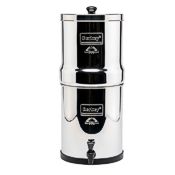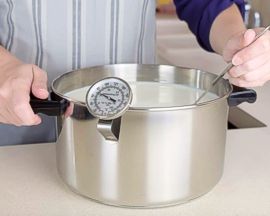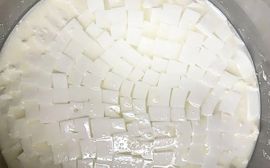Cheesemaking Resource Guide for Beginners
Cheesemaking is becoming increasing popular among home cooks, but knowing where to start can be intimidating. When researching how to begin, there are three basic aspects of cheesemaking to consider, the ingredients, equipment, and process. The articles linked to below, written by Ricki Carroll, are very helpful resources for learning how to enter the wonderful world of cheesemaking! A few common questions that beginning cheesemakers often wonder about are addressed further down on this page.
The following books provide easy to follow instructions and recipes, for both beginner and intermediate cheesemakers.
Cheesemaking Resource Books |
|||
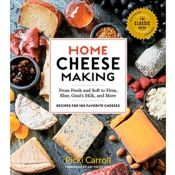 |
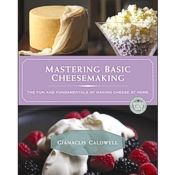 |
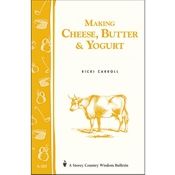 |
 |
| Home Cheese Making | Mastering Basic Cheesemaking | 使Cheese, Butter & Yogurt | Say Cheese! A Kids' Guide to Cheesemaking |
开始
Most homemade cheese is made from milk, bacteria and rennet. Cheese can be made from almost any kind of milk including cow, goat, sheep, skim, whole, raw, pasteurized and powdered.
Cheese making kitsare a great way for beginners to start making cheese at home. The Mascarpone Cheese Making Kit is one of the easiest kits to start with, and the 30 Minute Mozzarella Cheese Making Kit is also a good one to try! To make a variety of hard cheeses, the Basic Cheese Making Kit is a great choice.
The bookHome Cheese Makingwill talk you through the entire cheesemaking process and also includes over 75 cheesemaking recipes.
Shopping for Cheesemaking Supplies
When shopping for, it's a good idea to find a cheese recipie first, then make a list of the ingredients and equipment you'll need to make that cheese.
Using Non-Chlorinated Water
氯化水将前vent the enzyme action of rennet. If you don't know if your tap water is chlorinated, call your local water department to ask. If it is chlorinated, you can use distilled water, bottled spring water, or purify your tap water.Berkey water purifiersare an excellent choice for purifying water for use in cheesemaking.
Recalibrating a Thermometer
Since the cheesemaking process happens at temperatures similar to our healthy body temperatures, a good quality medical thermometer can be used to calibrate your thermometer.
- Run warm water between 88°-98° F into a container deep enough to immerse both thermometers.
- Place thermometers in the water, check temperature readings once they've stabilized.
- If your new thermometer is not reading at the same temp as the medical thermometer, locate the nut found under the dial head. Then, using a wrench, turn the nut clockwise or counterclockwise as needed until the needle reads the same temperature as the medical thermometer.
- Repeat this process every now and then to maintain your thermometer's accuracy.
Sanitizing Equipment
Cheese making uses specific bacterial cultures to ripen milk. To avoid contamination by unwanted bacteria, it is important to keep all equipment and surfaces clean and sanitized.
Surface Areas
We recommend using a food grade sanitizer to clean surface areas like the countertop. Before you begin making cheese, wipe down and dry your counters.
Utensils
Sterilize utensils in boiling water for 10 minutes, or run them through the dishwasher on a sanitize cycle.
Pots
Sterilize pots with boiling water for 10 minutes, or run them through the dishwasher on a sanitize cycle.
After many batches of cheese, a residue can build up on your pot called milk stone. The best way to remove this is with an acid based detergent for dairy use. Normally, alkaline based dairy cleaners are used to remove fat and proteins, but calcium deposits of milk stone need an acid based cleaner. Most dairies use the alkaline cleaner every day and acid cleaner once a week.
Cheesecloth or Butter Muslin
Before first using, it's best to hand wash your cheesecloth in cold water with a neutral detergent to remove all the sizing and process debris. Always rinse your cheesecloth or butter muslin in cold water immediately after removing your curds/cheese. This will prevent the milk proteins from bonding to your cloth. After you've rinsed in cold water, you may proceed to hand or machine wash your cloth in warm/hot water with a neutral detergent.
Controlling Heat
How to maintain temperatures when heating milk
The easiest way to keep a pot of milk at the correct temperature for long periods of time is to place it in your kitchen sink filled with hot water. As the milk heats to the target temperature, the water bath begins to cool. When needed, drain some water from the sink and add boiling water to raise the temperature. When starting the process the water in the sink should be 10°-15° F warmer than your target milk temperature. As you get within 7°-8° degrees of your target, reduce the water temperature to 2°-3° degrees above the milk target temperature.
How to raise the temperature 2° every 5 minutes
Temperature control can be tricky to figure out in the beginning. To increase the temperature slowly, add boiling water to the water bath so it stays 5°-10° degrees warmer than the milk temperature. When cooking curds, slow heating is only needed for the first 10-15 minutes. Once the curds have released a good amountof whey, you can heat much faster.
Clean Break in the Curd
To know when to cut the curd, poke your finger into the curd at a 45 degree angle, if the curd breaks neatly around your finger, the curd is ready to be cut. When it's ready, cut it immediately, if you wait, it will continue to firm and won't drain the whey properly.
Cheese Yields
The yield of cheese from one gallon of milk is approximately one pound for hard cheese and two pounds for soft cheese. The amount of butterfat in milk will affect the yield. Sheep's milk for instance, is 9% butterfat, so the yield will be much higher than that of goat's or cow's milk.
使Cheese at High Altitude
不需要任何更改在高海拔地区,因为re's nothing to boil for a cheese recipe.
使Cheese Without Refrigeration
You can make cheese with little or no refrigeration. Cheese has been made for centuries in every corner of the globe. If you have limited refrigeration, we suggest you make fresh cheese, most specifically, a Mediterranean or Central and South American style cheese. They depend on high acid and/or salt for preservation and are consumed quickly. This type of cheese includes Mozzarella, Feta, Paneer, Queso Fresco and Queso Blanco.
使Whey Protein
Unfortunately, it's difficult to make whey protein through home cheesemaking. Even larger cheese makers can't justify the energy needed to dehydrate the whey. It's primarily done by large operations that consolidate whey from many large plants.






